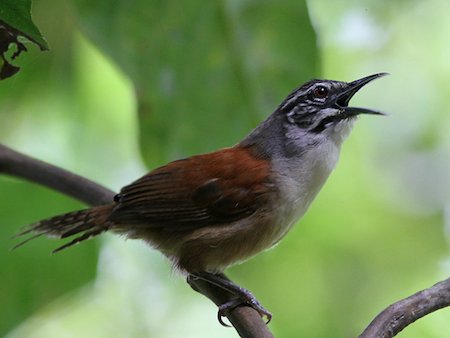State of Pará

Birding Pará
Pará is a state in northern Brazil traversed by the lower Amazon River. It borders the Brazilian states of (clockwise from north) Amapá, Maranhão, Tocantins, Mato Grosso, Amazonas and Roraima. To the northwest it also borders Guyana and Suriname, and to the northeast it borders the Atlantic Ocean. The capital and largest city is Belém, located at the mouth of the Amazon at the Atlantic Ocean and the 11th most populous city in the country.Pará is the most populous state of the northern region, with a population of over 7.5 million, being the ninth-most populous state in Brazil. It is the second-largest state of Brazil in area, with 1,2 million km², second only to Amazonas upriver. Its most famous icons are the Amazon River and the Amazon Rainforest.The climate is typical of a tropical rainforest climate with no dry season – all months have mean precipitation values of at least 60 millimetres (2.4 in). Although much of the state is still covered in rainforest large tracts suffer from illegal deforestation and land occupation, mostly due to cattle ranching and soya farming. The controversial Belo Monte Dam is a proposed hydroelectric dam complex to be built on the Xingu River; opponents believes that it threatens the habitat of a relatively undisturbed area of Pará’s rainforest, and would endanger several endemic fish species. It also is likely to attract further development and migration to the state, to the detriment of the state’s rainforest.Below are some of its top attractions and websites to the reserves and many places to stay where birding is an option.
-
Floresta Nacional de Carajás
InformationSatellite ViewThis mining town is administered by the Companhia do Vale do Rio Doce (091-327-5322 – Claudete or Thaís, 327-4126 - Venâncio). There is a good hotel and birding is along 40km of road through excellent, varied habitat, from humid forest to cerrado. Permission to bird outside the town limits is required and is obtainable from Ibama, in the town (091-346-1218 – Orlando Maia). The Carajás National Forest covers the Serra dos Carajás (Carajás Mountains), an area with large deposits of iron ore, and attempts to combine the roles of supporting mineral extraction with preserving the environment and maintaining biodiversity. -
Floresta Nacional de Caxiuanã
InformationSatellite ViewA reserve owned by the Goeldi Museum in Belém. You fly to Breves from Belém or take a boat (13 hours) and then go by launch (voadeira) to Caxiuanã. Accomodation is said to be comfortable but is expensive. Golden parakeet Guarouba guaruba is said to be a cert. Reservations through the Goeldi Museum in Belém (217-6058, caxiuana@museu-goeldi.br or caxiuana@amazon.com.br) -
Parque Nacional da Amazônia
InformationSatellite ViewGet to know the morototó, a tree looking not unlike a cecropia. When fruiting it is a magnet for tanagers, aracaris, cotingas, white-crested guan Penelope pileata, brown-chested barbet Capito brunneipectus and harlequin antbird Rhegmatorhina berlepschiNB Take plenty of bottled water as the Tapajós is polluted by mercury. -
Pousada Salto do Thaimaçu
WebsiteSatellite ViewThis fishing lodge on the Rio São Benedito is four hours drive on dirt roads from Alta Floresta. -
Santarém
Satellite ViewThe Floresta Nacional (FLONA) de Tapajós is administered by Ibama for the controlled exploitation of timber. There are two roads into the forest, one at km67 and the other at +/- km80, off the asphalt road south from Santarém. Permission to enter the FLONA is required from IBAMA in Santarém and the LBA, the research organisation studying the area.
-
Number of bird species: 1030
As at November 2016
-
Museu Paraense Emilio Goeldi
WebsiteThe Museum was born of idealists who believed in the future of the Amazon and the need to researching its natural resources, flora, fauna, rocks and minerals, indigenous groups, geography and history of the region and organizing scientific collections and public exhibitions to spread the knowledge generated.
-
NF Carajás National Forest
InformationSatellite ViewThe Carajás National Forest covers the Serra dos Carajás (Carajás Mountains), an area with large deposits of iron ore, and attempts to combine the roles of supporting mineral extraction with preserving the environment and maintaining biodiversity. -
NF Floresta Nacional de Caxiuanã
InformationSatellite ViewCaxiuanã is noted for its rich biodiversity, geographic isolation, and a very low population density. The national forest is the oldest in Amazônia Legal, a region that contains all 9 states in the Amazon Basin, and is also the second oldest national forest in Brazil. -
NP Parque Nacional da Amazônia
InformationSatellite ViewIt comprises 1,070,737 ha. It is situated in Itaituba and Trairão municipalities. Except for about 2% of more open forest, the whole park consists of dense humid tropical forest. The larger trees reach a height of about 50 m (160 ft), and the light filtering through the canopy is sufficient to produce a biodiverse understorey of vines, lichens, mosses and orchids.
-
Pousada Beira Rio - Rio Araguaia
Accommodationon the banks of the Araguaia River and overlooking the beaches of Muricí and Escapole, Pousada Beira Rio offers its guests a varied service of lodging, food, crossing to the beach, fishing and boat trips. -
Pousada dos Guar
AccommodationIf they tell you that paradise is on the Island of Marajó, believe me. And you can still enjoy much more at Pousada dos Guarás. The right place for you and your family to spend unforgettable moments of leisure, adventure and rest.
